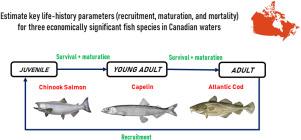一个机械阶段结构模型,用于估计加拿大水域三种经济上重要的鱼类的成熟,死亡率和招募参数
IF 3.2
3区 环境科学与生态学
Q2 ECOLOGY
引用次数: 0
摘要
本研究设计并分析了一个离散时间、阶段结构的模型,以估计加拿大水域三种经济上重要的鱼类:奇努克鲑鱼(Oncorhynchus tshawytscha)、毛鳞鱼(Mallotus villosus)和鳕鱼(Gadus morhua)的关键生活史参数(吸收、成熟和死亡率)。分析包括模型适定性、净繁殖数(R0)和均衡的全局稳定性。利用偏秩相关系数(PRCC)进行敏感性分析,评估关键参数对R0和长期鱼类种群丰度的影响。我们的研究结果表明,在这三个物种中,招募和成虫生存是长期种群可持续性的主要驱动因素。虽然成熟过渡对人口增长有积极贡献,但与招募和生存相比,它们的影响是次要的。这些结果突出了有效管理战略的重要性,这些战略应优先考虑改善捕捞和成鱼存活率,同时支持生命阶段之间的成功过渡,以保持鱼类种群稳定,并确保渔业的生态和经济可持续性。本文章由计算机程序翻译,如有差异,请以英文原文为准。

A mechanistic stage-structured model for estimating maturation, mortality, and recruitment parameters of three economically significant fish species in Canadian waters
This study designs and analyzes a discrete-time, stage-structured model to estimate key life-history parameters (recruitment, maturation, and mortality) for three economically significant fish species in Canadian waters: Chinook Salmon (Oncorhynchus tshawytscha), Capelin (Mallotus villosus), and Cod (Gadus morhua). The analysis encompasses model wellposedness, the net reproductive number (), and the global stability of equilibria. Sensitivity analysis using Partial Rank Correlation Coefficients (PRCC) was performed to assess the influence of key parameters on and long-term fish population abundance. Our findings reveal that recruitment and adult survival are the primary drivers of long-term population sustainability across all three species. While maturation transitions contribute positively to population growth, their influence is secondary compared to recruitment and survival. These results highlight the importance of effective management strategies that prioritize improving recruitment and adult survival while also supporting successful transitions between life stages to maintain stable fish populations and ensure the ecological and economic sustainability of fisheries.
求助全文
通过发布文献求助,成功后即可免费获取论文全文。
去求助
来源期刊

Ecological Modelling
环境科学-生态学
CiteScore
5.60
自引率
6.50%
发文量
259
审稿时长
69 days
期刊介绍:
The journal is concerned with the use of mathematical models and systems analysis for the description of ecological processes and for the sustainable management of resources. Human activity and well-being are dependent on and integrated with the functioning of ecosystems and the services they provide. We aim to understand these basic ecosystem functions using mathematical and conceptual modelling, systems analysis, thermodynamics, computer simulations, and ecological theory. This leads to a preference for process-based models embedded in theory with explicit causative agents as opposed to strictly statistical or correlative descriptions. These modelling methods can be applied to a wide spectrum of issues ranging from basic ecology to human ecology to socio-ecological systems. The journal welcomes research articles, short communications, review articles, letters to the editor, book reviews, and other communications. The journal also supports the activities of the [International Society of Ecological Modelling (ISEM)](http://www.isemna.org/).
 求助内容:
求助内容: 应助结果提醒方式:
应助结果提醒方式:


